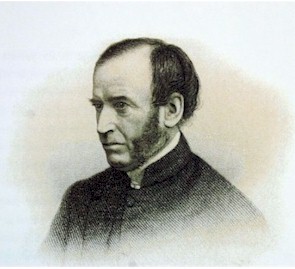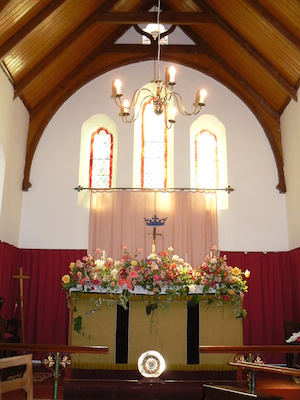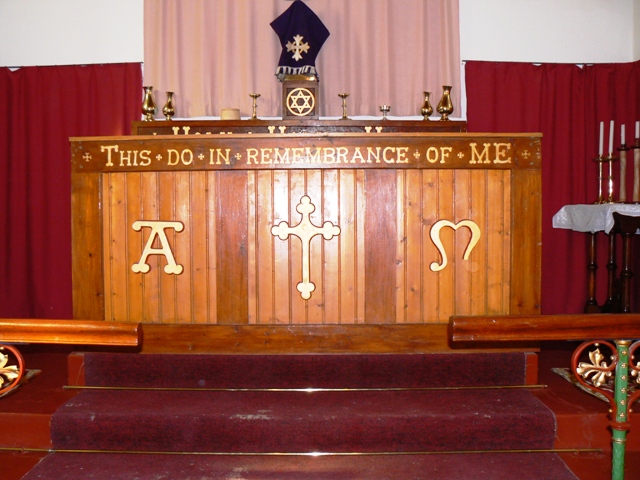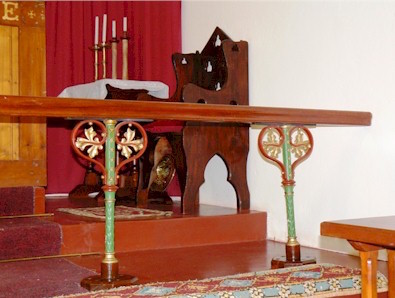The History of the Chapel of St John the Baptist, Prince Albert

Bishop Robert Gray, first Bishop of Cape Town, visited the little community at Prince Albert on the 29th October 1855 and conducted a service in the "Dutch" church. A mere handful of Anglicans lived here then, but by 1870 the Bishop had secured two erven for a school-chapel and a priest's residence. The first priority was a Mission School and he sent the Reverend John Gibbs to build the school, which was completed in 1871 and stands at the Mark Street end of the property. The Rev. Gibbs served as schoolmaster, conducting services in the Mission School.
In 1875, Bishop West-Jones, second Bishop of Cape Town, visited Prince Albert and held a service in the courtroom, since the Mission School had become too small for the congregation. This led him to promise £100 to build a bigger school-chapel, but twenty years were to pass before enough money was collected to make a start on the project.
Architect/builder George Wallis built St John’s, after completing St Jude’s in Oudtshoorn and the churches in Klaarstroom and Willowmore. His clerk of works was the local priest, the Rev. William Philip Southby, assisted by the Rev. William Breach from Plettenberg Bay.
The foundation stone was laid in 1895 - possibly on the Feast of St John the Baptist (24th June). The church was supposed to be completed by the end of the year but was delayed by a few months when the windows were late arriving from England.
St John’s is typical of late Victorian churches in small country towns: a simple building, not unduly decorated and lacking a spire or tower. It embodies architectural features typical of the period: buttressed walls with a stone plinth; roughcast plastered walls with smooth plaster surrounds to the windows and doors; parapets to the gables with cast iron finials to the porch and pre-cast crosses to the church walls; decorative ridge ventilators on the roof and small stained glass windows in the Gothic style with built-in vents.
The lancets of the leaded lights are of particular architectural interest, varying in height from 2 to 7 foot. Each is made up of a pleasing mix of pale pink, green and yellow lozenged panes, with a narrow scarlet border.
The interior of the building follows traditional lines, its length is on three levels: the nave, the chancel and the sanctuary - each accessed by steps.
In the sanctuary, the altar, a stout wooden framework with shelving board panels, provides the focal point of worship. The three front panels carry embellishments in gold and red: a cross between the symbols of alpha Αand omega Ω(Revelation 1:8). The side panels each carry a fleur-de-lis, a Trinitarian statement that the Godhead is threefold: Father, Son and Holy Spirit.
The Rev. Breach built and decorated the altar with its carved gradine (the ledge behind the altar) painted with "Holy, Holy, Holy", and the gold and red Star of David (reflecting Jesus’ lineage in Matthew 1:11) on the cubic wooden pedestal (for the tall brass altar cross).
He also created the scripture texts on a frieze around the interior of the church, a common feature in churches of the period.
The words of Matthew 11 : 28 and 29, Psalm 134 :1 and John 6 : 55 appear around the nave, over the chancel arch and on the east wall shields.
Next to the altar is a beautifully designed stinkwood credence table with turned legs, which holds the elements used for the Eucharist. On the other side is the Eucharistic President's Chair - used by the Bishop when he visits.
Supports for a communion rail, the brass altar cross and candlesticks and the ornate brass lectern were imported fromEngland at an early date.
The harmonium in the porch is a memorial to Queen Victoria’s Diamond Jubilee in 1897. The plaque recording this can be seen in the nave. Mrs. Florence Luttig was the church organist in those early days. Her daughter Betty Weatherhead lived to be 100 years old and shared many stories of the early days of St John's with us.
A small bronze plaque reminds us that the rood screen (the wooden structure under the arch carrying the rood or cross) was erected to mark peace at the end of the 1914 -1918 war.
The substantial cast concrete font is mounted on a large elegant marble pillar, all under a simple wooden cover and cross.
St John’s and the Mission School Hall have both been declared National Monuments.

Until the 1960's all our congregation lived in Bo-dorp, Rooikamp and Nuwerus, within comfortable walking distance of St John's. Then came the days of the forced removals and many members were resettled in North-end.
The congregation continued to worship at St John's and eventually a hall was constructed in North-end.
Morning Prayer is said there in Afrikaans every Sunday morning, except for the fourth Sunday of the month, when a Communion is held in the Church. Our Sunday School meets there and the hall is used for parish meetings, special events and by the wider community for concerts, celebrations and funerals and for fund-raising events for the parish.
From 1986, St. John's has been under the care of the Parish of Oudtshoorn. The Rector visits Prince Albert once a month to celebrate the Eucharist and perform baptisms.
On 2nd November 2003 the first Thanksgiving Service for HRH Prince Albert, consort to Queen Victoria was held in the church. The service was conducted in German and English and formed part of the local Oktoberfest celebrations for five years.
The church has hosted performances of Words and Music where locals provided lively entertainment in poetry, prose and music around a particular theme, and storytelling events to raise funds for restoration work.
For several years special singing classes for local children were held in the church by Dutch opera singer Bernadette ten Heyn while she was visiting the village.
The Mission School Hall has provided a venue for meetings by such diverse groups as the CANSA association, our Patchwork Dolls quilting group, the local VLV and the Cultural Society.
Funds raised have gone towards work in the chapelry, the restoration and maintenance of the buildings, purchasing a piano, building a new office block with toilets, constructing a ramp into the hall and the upkeep of the garden.
Most of the people who raised funds and carried out restoration work in the Church and the Mission School Hall from 2001 - 2011 were retired, some were in their eighties! In 2015 our Christian Men's Society took over the responsibility of maintaining the North-end hall.

The garden has slowly come to life. An indigenous garden in the shape of a cross lies to one side of the path and our Karoo Labyrinth on the other. Indigenous plants and trees, crushed Swartberg sandstone and Karoo rocks create quiet places within the church grounds from which you can look towards the mountains and the vast Karoo sky.
As part of the 2012 celebrations of Prince Albert's 250th year a Flower Festival was held in the Church and the local Patchwork and Quilters' Guild, known as The Patchwork Dolls, unveiled their Heritage Quilt, created especially for the occasion. It now hangs in the Prince Albert Library.
The St John's story continues on our Congregation page...
Information on this page was compiled from the Centenary booklet, including "Some notes collated by AJRB 1992" by Canon AJR Beddy.



